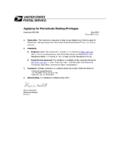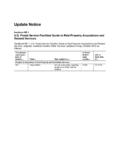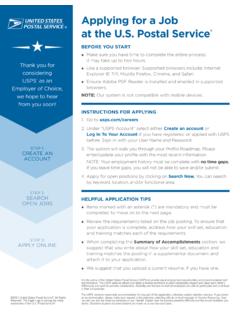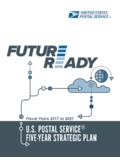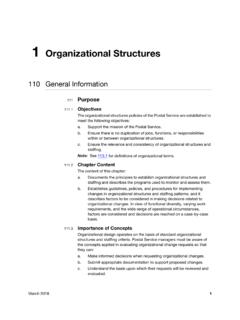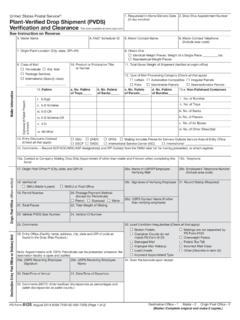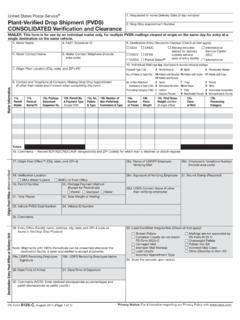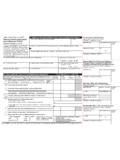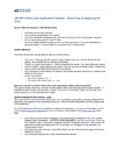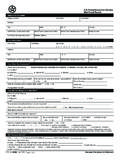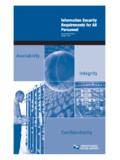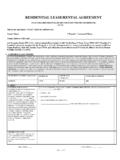Transcription of Contents
1 Contents 1 Introduction.. 1. 1-1 Purpose.. 1. 1-2 handbook Contents and Policy Owner .. 1. 1-3 Cloud security Background .. 2. 1-4 Supporting References .. 2. 1-5 Cloud Technology Initiatives.. 3. Cloud Solution.. 3. Hosted Solutions and Service-Based Contracts .. 3. 1-6 Major security Objectives for Cloud Technology .. 3. 2 Roles and Responsibilities .. 5. 2-1 Chief Inspector .. 5. 2-2 Executive Vice President and Chief information Officer .. 5. 2-3 Vice President, information Technology .. 5. 2-4 Vice President, Chief information security Officer .. 6. 2-5 Executive Sponsors .. 6. 2-6 Chief Privacy Officer .. 6. 2-7 Inspector General .. 6. 2-8 Contracting Officers and Contracting Officer Representatives .. 7. 2-9 Manager, Business Relationship Management .. 7. 3 Cloud Architectures .. 9. 3-1 Cloud Technology Models .. 9. 3-2 Cloud Technology Service Models .. 10. Software as a Service (SaaS) .. 10. Platform as a Service (PaaS).
2 11. Infrastructure as a Service (IaaS): .. 12. 4 Cloud security Concerns.. 15. 5 Cloud Risk Management .. 19. 5-1 Cloud-Specific Risks .. 19. 5-2 Attacks Against Cloud Technologies .. 21. May 27, 2015 i Cloud security 6 Cloud Technology security Requirements .. 23. 6-1 Cloud Providers and security .. 23. 6-2 Cloud Initiatives .. 23. 6-3 Administrative security .. 23. 6-4 Postal Service Applications and information .. 24. 6-5 Identity Management .. 24. 6-6 security Audit information .. 25. 6-7 Encryption.. 25. 6-8 Physical security .. 26. 6-9 Infrastructure and Application Assessment and Authorization.. 26. 6-10 Multi-Tenancy .. 26. 6-11 Data Deletion .. 26. 6-12 Continuity of Operations of CP.. 27. 6-13 Architecture .. 27. 6-14 Governance, Risk and Compliance .. 28. 6-15 Data Access Management .. 28. 6-16 Availability of Postal Service Applications and information .. 29. 6-17 Incident Response .. 30. 6-18 Application security .
3 30. 6-19 Infrastructure as a Service (IaaS) .. 30. 6-20 Platform as a Service (PaaS) .. 31. 6-21 Software as a Service (SaaS) .. 31. 6-22 Due Diligence .. 31. 7 Legal Considerations .. 33. 7-1 Contract Clauses .. 33. 7-2 Electronic Discovery .. 34. 7-3 Data Ownership .. 35. 7-4 Privacy .. 35. 8 Legal, Privacy, and information security Contract Requirements .. 37. 8-1 Background Questions for Contract.. 37. 8-2 Legal Requirements .. 37. 8-3 Privacy Contract Requirements .. 39. 8-4 information security Contract Requirements .. 40. Appendix 1 Cloud Terms and Definitions .. 41. ii handbook AS-805-H. 1 Introduction Cloud computing focuses on leveraging current technologies, information security safeguards, alignment of business objectives and responsibilities, infrastructure, risk mitigation, legal and contractual obligations, privacy requirements, integrated with the exchange and sharing of Postal Service data, and information resources.
4 1-1 Purpose The purpose of this handbook is to outline Postal Service policies, standards and requirements that apply to the use of cloud technologies, not addressed in the AS-805, information security . information covered in this handbook also includes mitigating security controls for conditions under which cloud technologies can be implemented as cost-effective, risk-based alternative processes. 1-2 handbook Contents and Policy Owner Business and administrative objectives, roles and responsibilities, contract obligations, risk management and legal obligations related to cloud technologies are included in the following chapters: a. Chapter 1: Introduction. b. Chapter 2: Roles and Responsibilities. c. Chapter 3: Cloud Architectures. d. Chapter 4: Cloud and security Concerns. e. Chapter 5: Cloud Risk Management. f. Chapter 6: Cloud Technology security Requirements. g. Chapter 7: Legal Considerations. h. Chapter 8: Legal, Privacy and information security Contract Requirements.
5 The policy owner of this handbook is the Chief information security Officer. Send questions and comments to May 27, 2015 1. 1-3 Cloud security 1-3 Cloud security Background Cloud technologies leverage the economies of scale and resource-balancing activities across an ecosystem of partners that include cloud service providers, data brokers and other relevant role players. Cloud technologies potentially run the risk of minimizing trust and confidence that customers have grown to expect from the Postal Service with respect to processing and protecting personal information . The challenge for the Postal Service is to maintain and sustain the confidence level of its customers, while ensuring a chain-of-trust across the architecture and legal structures that are established with cloud providers (CPs). Exhibit 1 represents an overview of cloud technology architecture, which identifies the major cloud components and their functions in cloud technology.
6 The high-level cloud conceptual technology model below defines five major components: cloud consumer, cloud provider, cloud carrier, cloud auditor and cloud broker. Each component is an entity (a person or an organization). that participates in a transaction or process and/or performs tasks in cloud technology. Exhibit 1. The Conceptual High-Level Model The five major components are defined as follows: a. Cloud Consumer: A person or organization that maintains a business relationship with, and uses service from Cloud Providers. b. Cloud Provider: A person, organization, or entity (also frequently referred to as cloud service provider) that is responsible for making a service available to Cloud Consumers. c. Cloud Auditor: A party that can conduct independent assessment of cloud services, information system operations, performance and security of the cloud implementation. d. Cloud Broker: An entity that manages the use, performance and delivery of cloud services and negotiates relationships between Cloud Providers and Cloud Consumers.
7 E. Cloud Carrier: The intermediary that provides connectivity and transport of cloud services from Cloud Providers to Cloud Consumers. 1-4 Supporting References The following handbook and management instruction provide additional implementation policy for this handbook : a. handbook AS-805, information security , is the overarching information security document. b. Management Instruction AS-800-2014-4, Cloud Computing Policy, outlines the processes and procedures that must be followed for all technology product and service solutions that use cloud computing 2 handbook AS-805-H. Introduction 1-6. technology. As with any project requiring technology support, business customers must initiate a conversation with their Business Relationship program manager using a documented Business Needs Statement. 1-5 Cloud Technology Initiatives Cloud technology can and does mean different things to different people. The common characteristics most interpretations share are: on-demand scalability of highly available and reliable pooled technology resources, secure access to metered services from nearly anywhere and displacement of data and services from inside to outside the organization.
8 While aspects of these characteristics have been realized to a certain extent, cloud technology remains a work in progress.. This document provides an overview of the security and privacy challenges pertinent to cloud technology and points out considerations the Postal Service should take when implementing a private cloud or public cloud environment. Cloud initiatives must comply with Postal Service information security policy delineated in handbook AS-805, section Cloud Solution A cloud solution enables network access to a shared pool of configurable virtualized technology resources ( , networks, servers, storage, applications and services) in which information technology-enabled capabilities are delivered as a service to multiple customers using the same technology resources. The cloud environment can be rapidly scaled up or down and tailored to serve multiple consumers on demand with minimal management effort or service provider interaction.
9 Hosted Solutions and Service-Based Contracts Cloud solutions must not be confused with the following: a. Hosted solutions that are managed and maintained by the supplier and provide physical separation of the hardware that is leased, purchased or isolated for the exclusive use of Postal Service. b. Service-based contracts where the supplier takes ownership and full responsibility for the security of the data. 1-6 Major security Objectives for Cloud Technology The major security objectives for cloud technology are as follows: a. Protect Postal Service information from unauthorized access, disclosure, modification or monitoring. This includes supporting identity management such that the Postal Service has the capability to enforce identity and access control policies on authorized users accessing cloud services. This also includes the ability of the Postal Service to make access to its data selectively available to other users.
10 May 27, 2015 3. 1-6 Cloud security b. Protect Postal Service information from supply chain threats, including ensuring the trustworthiness and reliability of the service provider. c. Prevent unauthorized access to cloud technology infrastructure resources. d. Deploy access control and intrusion detection technologies at the CP. and conduct an independent assessment to verify that they are in place. This includes (but does not rely on) traditional perimeter security measures in combination with the domain security model. e. Define trust boundaries between CP(s) and consumers to ensure that the responsibility for providing security is clear. f. Support portability such that the Postal Service can take action to change CPs when needed to satisfy availability, confidentiality and integrity requirements. This includes the ability to close an account on a particular date and time, to copy data from one CP to another and then have the data completely purged from the prior CP resources.
